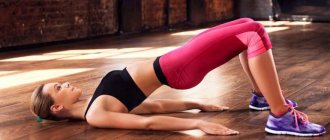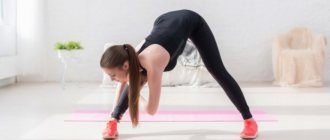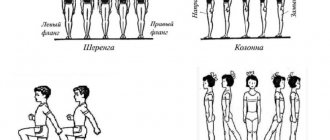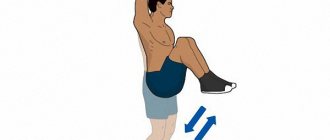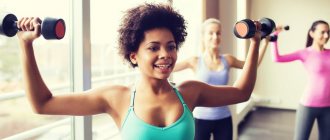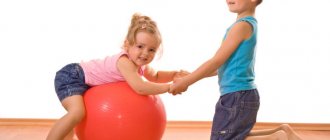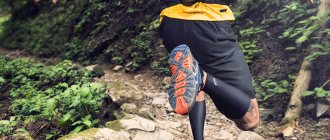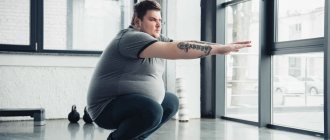Publication date: December 24, 2020.
Hanging leg raises are a basic exercise for working your abs. It combines simplicity and versatility with great efficiency.
To perform it, a simple bar will be enough, while hanging raises will not only help to create a powerful press, affecting primarily its lower part, but will also allow you to strengthen your legs, arms and core muscles.
Exercise can be part of a training program whose main goal is weight loss.
This article will give you all the information you need about hanging leg raises.
What muscles work
The stomach is the most problematic area for both women and men. As you know, in order to burn fat in the body, it is necessary to normalize your diet and perform regular cardio training.
But abdominal exercises also help eliminate excess belly fat. Their regular implementation allows you to improve blood circulation in this area, as a result, fat will burn faster.
When lifting legs while hanging, the following are involved:
- rectus abdominis muscle;
- oblique muscles;
- muscles of the anterior thighs;
- wrist flexor muscles;
- latissimus muscles.
Exercise options
There are three main options:
- standard : leg lifting is performed on the crossbar, in this case it is necessary to make an effort to keep the body motionless during the approach, preventing swinging;
- wall bars: in this case, the back rests against the wall, which makes it possible to fully concentrate on working the target muscles, without being distracted by stabilizing the body, this option is especially good for beginners.
- Another option is to use parallel bars instead of the wall bars, which also provide reliable support for the lower back.
The legs can be bent or kept straight during the exercise. The first option is simpler and is good for beginners.
It assumes that the knees are positioned higher than the pelvis when the legs are raised up with the shins hanging vertically. The straight leg raise is more difficult and is a great exercise for advanced athletes.
You can also add a side twist to the vertical movement. This method of performing the exercise will allow you to properly load the oblique abdominal muscles to make your torso powerful and strong.
Grip options
The exercise can be performed with either a direct or reverse grip. These options differ in the nature of the load on the arms, shoulders and back muscles. Which one to choose is mostly a matter of taste.
https://youtu.be/r9ZHjRX5MMg
Methodological instructions for performing exercises in hanging positions.
Hanging and supporting exercises must be performed in series of 4-6 exercises alternately and each series repeated 2-3 times. This dosage is needed for the reason that performing a separate exercise in a hanging position and an emphasis is short-term in duration and does not require large energy expenditures, and as a result, the training effect does not bring a positive effect.
When performing these exercises in series and repeating them several times, the duration of motor activity increases to 50-60 seconds, the load increases significantly, and the pulse value reaches 130 or more beats/min. And when carrying out exercises in hangs and supports using the flow method and the game method, their intensity increases even more and reaches a level with a pulse value of up to 150-160 beats/min. Such a load meets the necessary requirements that are imposed on the body of those involved and creates conditions for restructuring the structure of skeletal muscles and their mechanisms of not only aerobic, but also anaerobic energy supply. This achieves a training effect on individual muscle groups and on the entire body as a whole. This method is the simplest and most accessible for increasing the effectiveness of hanging and supporting exercises.
All exercises in hangs and supports must be performed with clear fixation of each pose for 3-6 seconds. with the obligatory observance of correct posture, in a strictly gymnastic style, beautifully and easily. Careless performance of these exercises, especially at the learning stage, is unacceptable.
Training in hanging and supported exercises is carried out using the methods of demonstration, storytelling, practical implementation using techniques in fixing a pose, belaying and self-insurance, and assisting each other. When learning simple exercises related to taking and holding poses, as a rule, a rotating method of organizing classes is used, where one part of the students performs the exercises, while the other controls the execution and helps their friends. The teacher usually only needs to tell the children the sequence of exercises in the series and the number of repetitions. When selecting exercises in a series, it is necessary that the exercises are equivalent in complexity, and that transitions from one to another are performed easily, without delay.
We offer several approximate series of hanging and supported exercises performed on various equipment:
Oro complex on a gymnastic wall
Oro complex on a gymnastic bench
Execution technique
At first glance, the technique of this exercise is very simple:
- grab the bar, stretching your legs down freely;
- as you exhale, quickly, but without jerking, pull your knees to your chest, bending your legs at an angle of more than 90 degrees;
- while inhaling, gently lower your legs;
- Do the required number of repetitions, then rest and move on to the next set.
In fact, doing the required number of repetitions of leg raises is quite difficult. The body must be motionless when performing it. The legs must be lifted smoothly, without jerking, through a powerful exhalation, while you should feel how the abs work.
Common Mistakes
Common mistakes include:
- swinging the body during the exercise;
- performing leg lifts with jerks;
- improper breathing.
As noted above, when performing exercises on the crossbar, it is necessary to prevent the body from swaying. The legs need to be raised quickly, but without jerking, through a powerful exhalation, while mentally concentrating on the work of the abs.
Don’t be afraid to breathe loudly, even if you are working out in the gym - it is a powerful exhalation while lifting your legs that will allow you to fully load your abdominal muscles.
If you perform the exercise with the wrong technique, the effect will be minimal.
Those who cannot do leg raises on the bar should perform this exercise on the wall bars. Another option is to replace it with lying leg raises or other abdominal exercises.
Back exercises on the wall bars
The wall bars perfectly help maintain the health of the spine, strengthen the back and prevent pain.
If you have certain pathologies, consult a specialist before starting training.
Pay attention to the following complex:
- The left leg is on the wall. The foot is parallel to the floor surface. Hands are placed on the bar at the shoulder line. Rotations of the lower limb are performed in the hip area 8-10 times.
- Same starting position. Spring flexions are performed in the knee joint area (5-6). Hands take hold of the crossbar. The torso must be kept stable. The foot of the active limb is located horizontally.
- From the same starting position, grab the bar on the sides of your leg with your hands. Make 8-10 bends towards the straight limb of the body without changing the position of the foot.
- Place your foot on the bar and tilt your body, resting your hands on the apparatus. Place your other foot at an angle of about 45 degrees. Pull the pelvis forward towards the wall, rotating the limb in the hip area. A deflection is performed in the lower back, and the body leans forward towards the leg, which is on the wall. The second limb then does the same.
- One leg is straightened and placed on the wall. Do 6-10 smooth springy bends with your body forward, placing your hands on the foot of this leg. When doing the last repetition, stay at the bottom for 10-15 seconds. The same is done for the second leg.
- Stand with your side to the wall, place one leg pointing to the side at a right angle on the crossbar. Make 8-10 body tilts towards the straightened second leg, trying to touch the floor with your fingers or palms. When performing the last incline, hold for 10-15 seconds. Do the same for the second limb.
- Stand facing a wall with your feet wide apart and grasping it near your chest. Make 8-10 rotations alternately inward and forward with both legs at the hip joint, trying to spread your legs as wide as possible.
- Similar starting position. Turn to the left and lower yourself as far as you can into a split position, performing springy movements. Turn around and go into a split on the other side.
- Stand with your right side facing the apparatus and grab the bar with the same hand. Keep your feet together. Perform 10 steps forward with your left leg straightened, gradually increasing the amplitude. Then turn to the other side and repeat the same for the second limb.
- You need to stand in front of the wall. Take the bar with your right hand and place your left hand at waist level. Place your legs together and make 10 swings with one of them, tilting your body. For the other side the actions are similar.
- You need to stand with your right side to the wall, grab it with your right hand along the chest line, and with your left hand along the waist line. Lower limbs together. For each of them, 10 back swings are performed.
- Stand against the wall with your right side. Bend the leg next to you at the knee joint and place it point-blank on the bar. Grasp the projectile with your hand slightly below the knee. Spring bends with the torso forward are performed. You need to try to reach the surface with your fingers or palms. For the other leg, the manipulations are similar.
- Stand with your back against the wall. Lean on your left leg and throw the other one over the bar. Place your right hand above your leg, approximately in line with your shoulder. Bend your back and perform 10 repetitions back and forth in the hip area. The same is done for the opposite side.
- Stand with your back to the wall. Grab the step above your face and bend your lower back. body back, each time grabbing the lower bars.
Photos will help you better understand how to perform the exercises.
Interesting Facts
American scientists from San Diego conducted research to determine the most effective exercises for working out the abs.
They used an electromyograph to evaluate the stress placed on the abdomen by the most popular abdominal exercises.
In the Top 7 exercises, which they compiled based on testing results, hanging leg raises took second place. The first one was the “bicycle” exercise. According to the scientists' results, hanging leg raises are 112% more effective than the reverse crunch , which is in seventh place in this ranking of effectiveness.
However, even before the study by American scientists, hanging leg raises were always included in various ratings of the best exercises for the abs.
They have traditionally been considered the most effective way to pump the lower part of the rectus abdominis muscle, which was confirmed by electromyography.
Hanging leg raises are the most energy-intensive and difficult abdominal exercise. For this reason, it is not suitable for everyone - women and beginners may either postpone its inclusion in their training program or not perform it.
There are many other abdominal exercises that can be used instead. Also, hanging raises have contraindications - injuries to the shoulder joints and problems with the lower back.
Women also need to note that this exercise targets the oblique muscles, so including it in a training program may cause the waist to disappear, resulting in a masculine torso.
If you do decide to do hanging raises, make sure you use proper technique throughout the entire approach.
It is better to do a small number of quality repetitions than many repetitions with poor technique, such as swinging the body and lifting the legs with jerks.
Recommendations
To make the classes useful and effective, consider these tips:
- Start with the minimum number of repetitions. To begin with, a couple of approaches of 8-10 times is enough. Gradually the number of repetitions needs to be increased.
- Exercises that involve hanging can be done for a while, or you can just hang for as long as you can.
- If you have any health problems, then a set of exercises and the frequency of performing them should be prescribed by a doctor. For prevention, it is enough to perform them 3-4 times a week.
- The same frequency is optimal for losing weight. If you are working a specific muscle group, then keep in mind that it needs to be given time to recover for at least 3 days.
The wall bars are a universal device that can be placed at home and practiced both for your figure and for your health. It is important to adhere to the correct exercise technique. You can watch the effective complexes in the video.
https://youtu.be/73IkD9T2lyI
